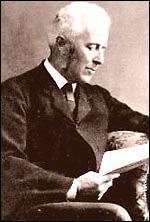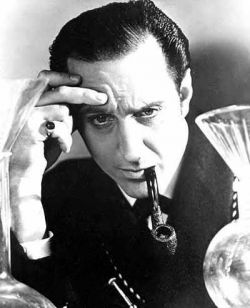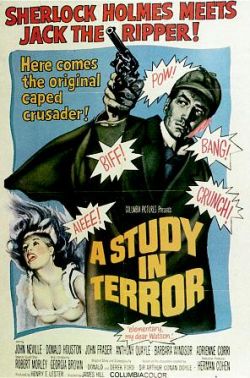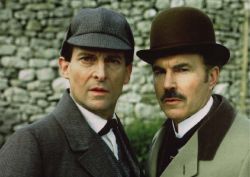The Original Caped Crusader
By Philip Schweier
March 13, 2007 - 06:54
 |
| Dr. Joseph Bell, the inspiration behind Sherlock Holmes |
Holmes was created by Sir Arthur Conan Doyle, who, as a young medical student, encountered teacher/physician Dr. Joseph Bell (1837-1911) at the University of Edinburgh. Bell had a reputation for being able to discern an extraordinary number of details of a person’s life merely through observation and deduction. A seemingly cursory examination could reveal facts about a person’s profession, family circumstances, and general health.
Doyle used his former instructor as a template in creating Holmes, who made is debut in the November 1887 issue of Beeton’s Christmas Annual. Over the next 40 years, Doyle would go on to pen 53 short stories and four novels featuring the master detective.
 |
Early stories are quite inventive, displaying Doyle’s creative foray into the unexplored realm of detective fiction. The public were immediately taken with the elementary fashion that Holmes untangled the various twists and turns. Illustrations by Sydney Paget cemented the public image that has become recognizable around the world: tall and slender, with a high forehead, and the familiar deerstalker hat and briar pipe.
 |
| The Strand Magazine, where most Sherlock Holmes stories were published. |
In 1899, William Gillette, with the endorsement of Doyle, wrote and starred in a play that debuted in New York. Legend has it that when Gillette asked permission from Doyle to marry Holmes off, Doyle’s response was indifferent, "You can marry him, or kill him, or anything you want," giving Gillette carte blanche to do as he pleased with the character.
However, less than two years later, Doyle’s enthusiasm for Holmes returned. While on vacation in Norfolk, the author was taken with the eerie moors, finding it a worthy location for what may be the detective’s most famous novel, The Hound of the Baskervilles. Crafting a tale full of creepy settings and spooky legends, it was reasoned that this story took place before Holmes untimely demise, and was published in serial format from August 1901-April 1902 in The Strand.
Nevertheless, the tale opened open a floodgate of enthusiasm among fans of the detective, leading Colliers magazine, which had published the stories in the United States, to offer Doyle an astronomical sum to create new mysteries for Holmes. Holmes was resurrected for 13 new cases. The first, “The Empty House,” was released in 1903.
Holmes’ final adventure, “The Adventure of Shoscombe Old Place,” saw print in the April 1927 issue of The Strand. While it had been almost 40 years since Holmes was introduced, the story takes place just prior to the Great War, cementing him and his companion, Dr. Watson, firmly in turn-of-the-century territory
In addition to William Gillette’s stage portrayal of the famous sleuth, other actors would assume the mantle of the famous detective. Among them were Eille Norwood – whose talent for stage makeup made him the perfect choice for those stories in which Holmes went about in disguise – and Arthur Wotner, who was the spitting image of Paget’s drawings.
 |
| Basil Rathbone, as the Great Detective |
However, despite what is one of the most popular film portrayals of the character, the detective was updated to contemporary times. Holmes became a defacto super-spy on behalf of His Majesty’s government, ferreting out saboteurs and battling Nazi spy rings. A total of 12 films were released by Universal between 1942-1946, borrowing elements from Doyle’s writings.
During this time, Rathbone and co-star, Nigel Bruce, also starred in a radio show as Holmes and Watson, with most of the episodes based directly on Doyle’s original stories. Sir John Gielgud and Sir Ralph Richardson later took over the roles in the years that followed.
On screen, Rathbone was a hard act to follow, and Sherlock Holmes on film was rather rare in the years to follow. When Hammer Films began making remakes of some of the classic Universal horror films, The Hound of the Baskervilles (1959) was among them, starring Peter Cushing.
 |
| Posters for A Study in Terror capitalized on the wave of Batmani sweeping America |
Other films that followed include The Private Life of Sherlock Holmes (1970), starring Robert Stevens. Depicting many of Holmes failings, such as his drug habit, it was directed by Billy Wilder, who regarded it as his own personal tribute to the famous slueth. In 1976, Holmes bested his addiction in the movie The Seven Per Cent Solution. Nicol Williamson starred with Robert Duvall as Watson and Alan Arkin as Dr. Sigmund Freud in a tale directed by Nicholas Meyer, based on his novel. According to the story, Watson fabricated Holmes’ demise at the hands of Moriarty to conceal the detective’s recovery from his cocaine addiction. In 1979, Christopher Plummer starred in Murder by Decree, as Holmes once again takes on the infamous Ripper murders of 1889.
 |
| Jeremy Brett and David Burke made a better Holmes and Watson than ever seen before. |
In comics, Holmes has had fleeting success. There were a handful of adaptations during the 1940s, at the height of Rathbone’s popular series of movies, as well as a smattering throughout the 1950s and ‘60s. In 1975, DC published a single issue, adapting “The Final Problem” and “The Empty House” as a complete story. In the 1980s, Batman and other DC sleuths such as Elongated Man and Slam Bradley would find themselves joining forces with an aged and remarkable spry Holmes for a special anniversary issue of Detective Comics.
 |
| The Cases of Sherlock Holmes, from Renegade Press. Note the resemblance to Rathbone |
Another handful of stories, combining the Holmes legend with other Victorian-era stories such as The Invisible Man and War of the Worlds, were published by Eternity Comics in the late ‘80s, and again in a collected format by Malibu.
Today, Holmes continues to charm new generations of readers, and inspire new entries in the genre of detective fiction. Those would include Monk, the television adventures of a neurotic but insightful detective, aided by his nurse, and House, M.D., another show about a pompous but perceptive physician whose lifestyle is similar to that of Sherlock Holmes.
Praise and adulation? Scorn and ridicule? E-mail me at philip@comicbookbin.com
Related Articles:
Review: Detective Comics #1008
Review: Detective Comics #1007
Review: Detective Comics #1006
Review: Detective Comics #1005
Review: Detective Comics Annual #2
Review: Detective Comics #1004
Review: Detective Comics #1003
Review: Detective Comics #1002
Review: Detective Comics #1001
Review: Detective Comics #1000
